Dual-Band and Wideband Bandpass Filters Using Coupled Lines and Tri-Stepped Impedance Stubs
Abstract
1. Introduction
- The DBBPF based on coupled lines and TSIOSs had wide passbands with 3 dB FBWs of 38.04% and 22.36%.
- The center frequency ratio of the DBBPF was 1.65, indicating close passbands separated by a single transmission zero, with a rejection greater than 20 dB.
- The realized WBBPF using coupled lines and TSISSs had a very good selectivity factor of 0.90.
2. Design and Analysis of Proposed BPFs
- (a)
- DBBPF using coupled lines and TSIOSs
- (b)
- WBBPF using coupled lines and TSISSs
3. Results and Discussion
4. Conclusions
Funding
Conflicts of Interest
References
- Luo, X.; Cheng, X.; Han, J.; Zhang, L.; Chen, F.; Guo, Y.; Xia, X.; Deng, X. Compact dual-and bandpass filter using defected SRR and irregular SIR. Electron. Lett. 2019, 55, 463–465. [Google Scholar] [CrossRef]
- Troudi, Z.; Macháč, J.; Osman, L. Compact dual-band bandpass filter using a modified hexagonal split ring resonator. Microw. Opt. Technol. Lett. 2020, 62, 1893–1899. [Google Scholar] [CrossRef]
- Roshani, S.; Yahya, S.I.; Mezaal, Y.S.; Chaudhary, M.A.; Al-Hilali, A.A.; Mojirleilani, A.; Roshani, S. Design of a Compact Quad-Channel Microstrip Diplexer for L and S Band Applications. Micromachines 2023, 14, 553. [Google Scholar] [CrossRef]
- Wu, X.; Wan, F.; Ge, J. Stub-loaded theory and its application to balanced dual-band bandpass filter design. IEEE Microw. Wirel. Compon. Lett. 2016, 26, 231–233. [Google Scholar] [CrossRef]
- Wang, Y.X.; Chen, Y.L.; Zhou, W.H.; Yang, W.C.; Zen, J. Dual-band bandpass filter design using stub-loaded hairpin resonator and meandering uniform impedance resonator. Prog. Electromagn. Res. Lett. 2021, 95, 147–153. [Google Scholar] [CrossRef]
- Xie, Y.; Chen, F.C.; Li, Z. Design of dual-band bandpass filter with high isolation and wide stopband. IEEE Access 2017, 5, 25602–25608. [Google Scholar] [CrossRef]
- Xiong, Y.; Wang, L.T.; Zhang, W.; Zhang, F.; Pang, D.; He, M.; Zhao, X.; Ji, L. Design of dual band bandpass filter with closely spaced passbands and multiple transmission zeros. Prog. Electromagn. Res. Lett. 2017, 70, 45–51. [Google Scholar] [CrossRef]
- Zhang, Z.-C.; Chu, Q.-X.; Chen, F.-C. Compact dual-band bandpass filters using open-/short-circuited stub-loaded λ/4 resonators. IEEE Microw. Wirel. Compon. Lett. 2015, 25, 657–659. [Google Scholar] [CrossRef]
- Song, F.; Wei, B.; Zhu, L.; Cao, B.; Lu, X. Dual-band high temperature superconducting bandpass filter using quint-mode stub-loaded resonators. IEEE Trans. Appl. Supercond. 2015, 25, 1501410. [Google Scholar] [CrossRef]
- Sun, M.; Chen, Z.; Zuo, T.; Zuo, Z.; Zhang, A. A high selectivity dual-band bandpass filter using quadruple-mode multi-stub loaded ring resonator (SLRR). Int. J. RF Microw. Comput.-Aided Eng. 2021, 31, e22667. [Google Scholar] [CrossRef]
- Mo, Y.; Fan, Y.; Tao, P.; Song, K. Miniaturised dual-band bandpass filter using modified SIR. Electron. Lett. 2013, 49, 888–890. [Google Scholar] [CrossRef]
- Moattari, A.M.; Bijari, A.; Razavi, S.M. A new compact microstrip dual bandpass filter using stepped impedance and λ/2 bended resonators. Int. J. RF Microw. Comput.-Aided Eng. 2021, 31, e22568. [Google Scholar] [CrossRef]
- Alazemi, A.J. A compact diamond-shaped dual-band bandpass filter with multiple transmission zeros. AEU—Int. J. Electron. Commun. 2023, 162, 154591. [Google Scholar] [CrossRef]
- Xu, J.; Xu, K.D.; Zhang, M.; Chen, Q. Dual-band bandpass filter using two simple coupled microstrip rings. Eng. Rep. 2021, 3, e12288. [Google Scholar] [CrossRef]
- Li, D.; Wang, J.A.; Liu, Y.; Chen, Z.; Yang, L. Yang Selectivity-enhancement technique for parallel-coupled SIR based dual-band bandpass filter. Microw. Opt. Technol. Lett. 2021, 63, 787–792. [Google Scholar] [CrossRef]
- Abdel-Aziz, M.; Anwer, S.; El-Hameed, A.; Awamry, A.A.; Mohra, A.S. Dual-band broadside-coupled based BPF with improved performance. AEU—Int. J. Electron. Commun. 2021, 138, 153895. [Google Scholar] [CrossRef]
- Arora, A.; Madan, A.; Bhattacharjee, M.; Nayak, C.; Kumar, K.V.P.; Thipparaju, R.R. Implementation of a compact dual-band bandpass filter using signal interference technique on paper substrate. AEU—Int. J. Electron. Commun. 2020, 123, 153262. [Google Scholar] [CrossRef]
- Shriram, S.Y.; Kumar, K.V.P.; Karthikeyan, S.S. Compact dual-wideband bandpass filter for wireless applications. AEU—Int. J. Electron. Commun. 2018, 95, 69–72. [Google Scholar] [CrossRef]
- Wang, H.; Chu, Q.X.; Gong, J.Q. A compact wideband microstrip filter using folded multiple-mode resonator. IEEE Microw. Wirel. Compon. Lett. 2009, 19, 287–289. [Google Scholar] [CrossRef]
- Feng, W.; Gao, X.; Che, W.; Xue, Q. Bandpass filter loaded with open stubs using dual-mode ring resonator. IEEE Microw. Wirel. Compon. Lett. 2015, 25, 295–297. [Google Scholar] [CrossRef]
- Nwajana, A.O.; Obi, E.R. Application of Compact Folded-Arms Square Open-Loop Resonator to Bandpass Filter Design. Micromachines 2023, 14, 320. [Google Scholar] [CrossRef]
- Cheng, T.; Tam, K.W. A wideband bandpass filter with reconfigurable bandwidth based on cross-shaped resonator. IEEE Microw. Wirel. Compon. Lett. 2017, 27, 909–911. [Google Scholar] [CrossRef]
- Zheng, X.; Pan, Y.; Jiang, T. UWB Bandpass Filter with Dual Notched Bands Using T-Shaped Resonator and L-Shaped Defected Microstrip Structure. Micromachines 2018, 9, 280. [Google Scholar] [CrossRef] [PubMed]
- Yang, Q.; Shu, M.; Guo, C.; Li, J.; Zhang, A. High selectivity wideband bandpass filter based on stepped impedance open stubs loaded ring resonator. AEU—Int. J. Electron. Commun. 2020, 126, 153408. [Google Scholar] [CrossRef]
- Sanchez-Soriano, M.A.; Quendo, C. Systematic design of wideband bandpass filters based on short-circuited stubs and transmission lines. IEEE Microw. Wirel. Compon. Lett. 2021, 31, 849–852. [Google Scholar] [CrossRef]
- Zhang, R.; Zhu, L. Design of a wideband bandpass filter with composite short-and open-circuited stubs. IEEE Microw. Wirel. Compon. Lett. 2013, 24, 96–98. [Google Scholar] [CrossRef]
- Da Xu, K.; Zhang, F.; Liu, Y.; Liu, Q.H. Liu Bandpass filter using three pairs of coupled lines with multiple transmission zeros. IEEE Microw. Wirel. Compon. Lett. 2018, 28, 576578. [Google Scholar]
- La, D.S.; Guan, X.; Wang, M.Y.; Mi, R.Q. Compact wideband bandpass filter based on coupled line stub with high selectivity. AEU—Int. J. Electron. Commun. 2021, 138, 153872. [Google Scholar] [CrossRef]
- Sheikhi, A.; Alipour, A.; Mir, A. Design and Fabrication of an Ultra-Wide Stopband Compact Bandpass Filter. IEEE Trans. Circuits Syst. II Express Briefs 2020, 67, 265–269. [Google Scholar] [CrossRef]
- Zhang, X.; Wu, Y.; Yu, H.; Wang, W.; Yang, Y.; Gao, J. High selectivity wideband bandpass filters based on flexibly transferring the structure of a coupled-line. AEU—Int. J. Electron. Commun. 2022, 155, 154334. [Google Scholar] [CrossRef]
- Da Xu, K.; Luo, Z.; Liu, Y.; Liu, Q.H. High-selectivity single-ended and balanced bandpass filters using ring resonators and coupled lines loaded with multiple stubs. AEU—Int. J. Electron. Commun. 2018, 96, 193–198. [Google Scholar]
- Cui, L.; Wang, W.; Zhuang, Z.; Li, S.; Wu, Y.; Liu, Y.A. High Selectivity Wideband Bandpass Filter Based on Transversal Signal-Interaction Concepts Loaded with Open and Shorted Stubs. Prog. Electromagn. Res. Lett. 2016, 64, 133–139. [Google Scholar] [CrossRef]
- Kumar, K.V.P.; Karthikeyan, S.S. Compact, high selectivity and wideband bandpass filter with multiple transmission zeros. AEU—Int. J. Electron. Commun. 2018, 94, 79–83. [Google Scholar] [CrossRef]
- Narayane, V.B.; Kumar, G. A selective wideband bandpass filter with wide stopband using mixed lumped-distributed circuits. IEEE Trans. Circuits Syst. II Express Briefs 2022, 69, 3764–3768. [Google Scholar] [CrossRef]
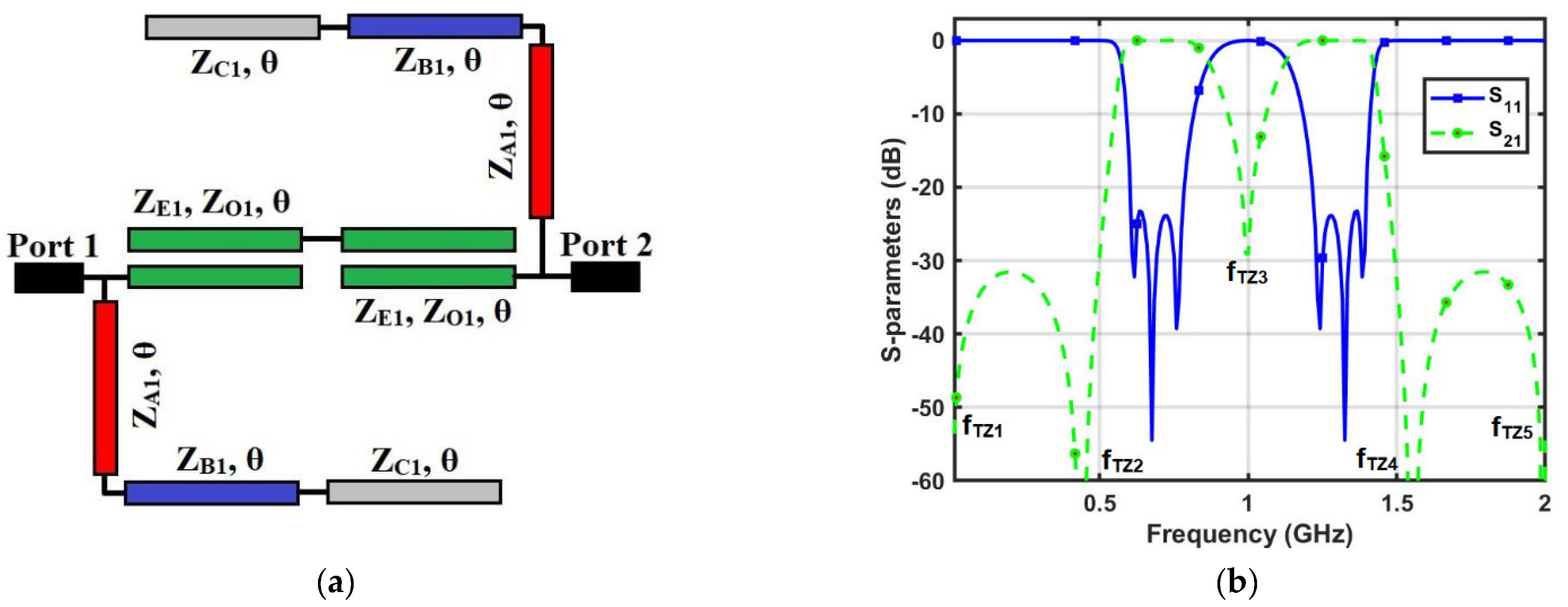
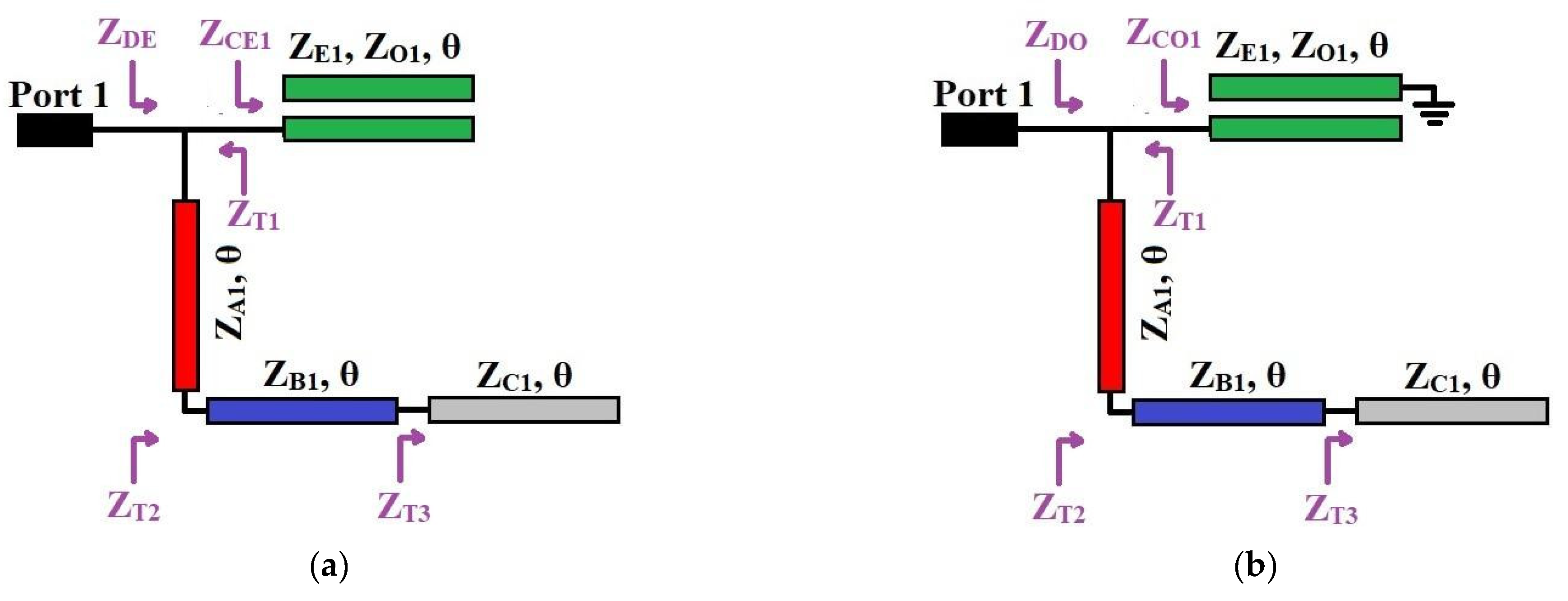

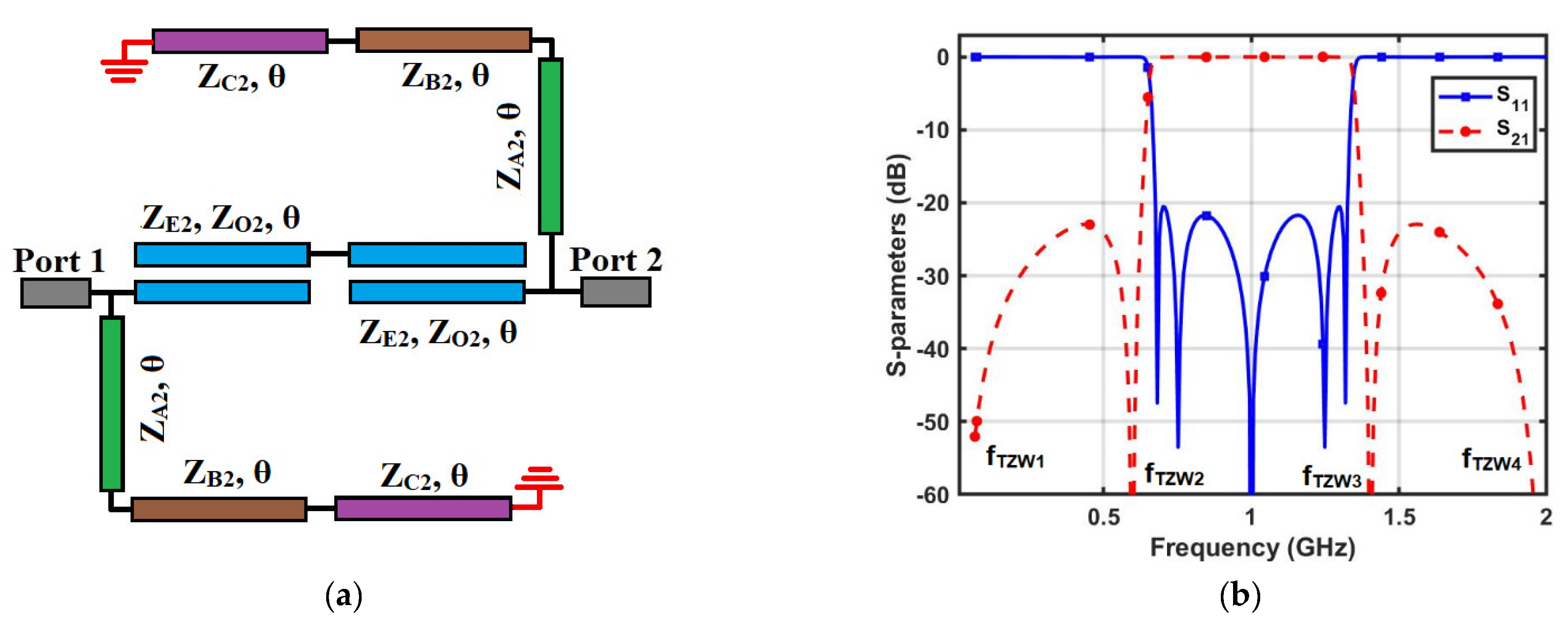
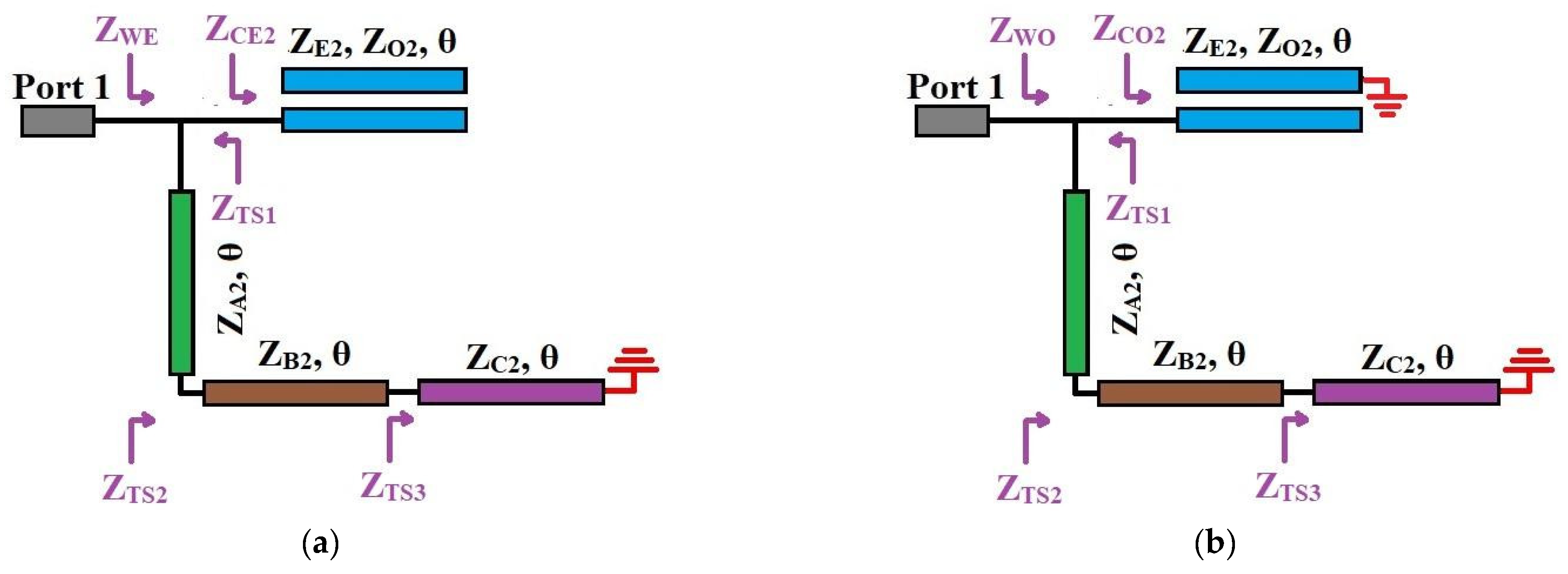
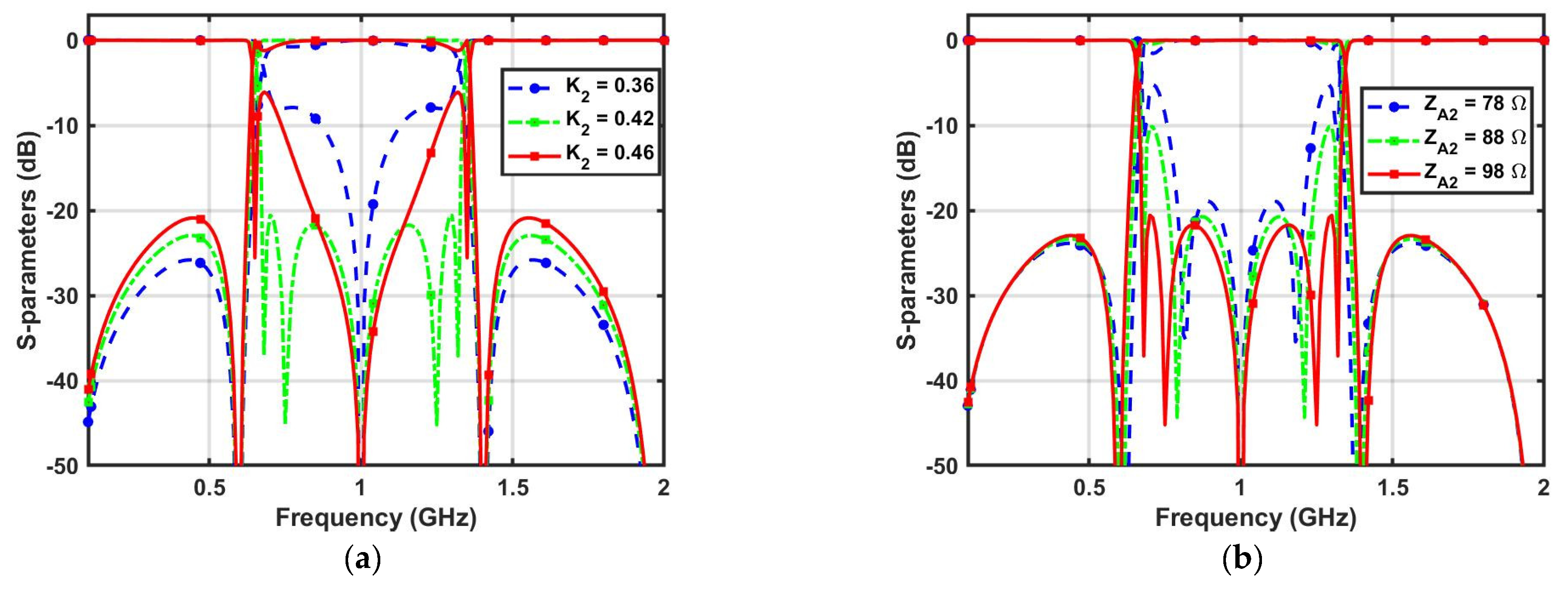
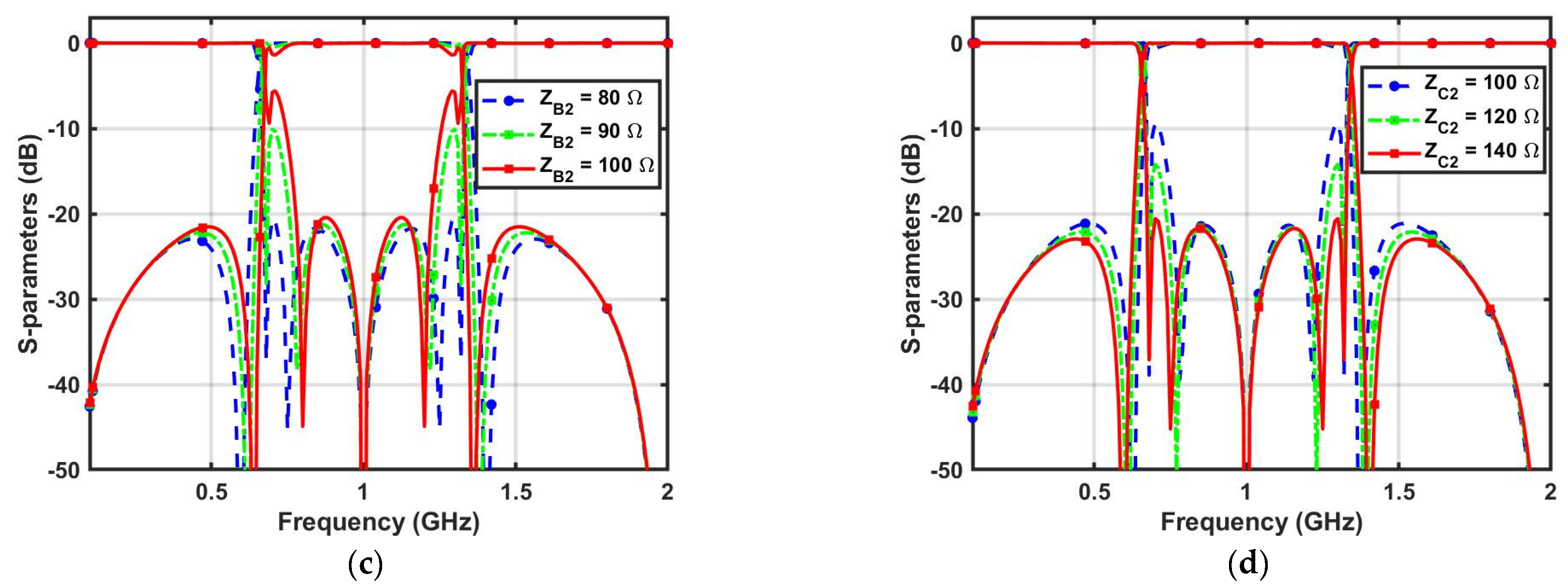
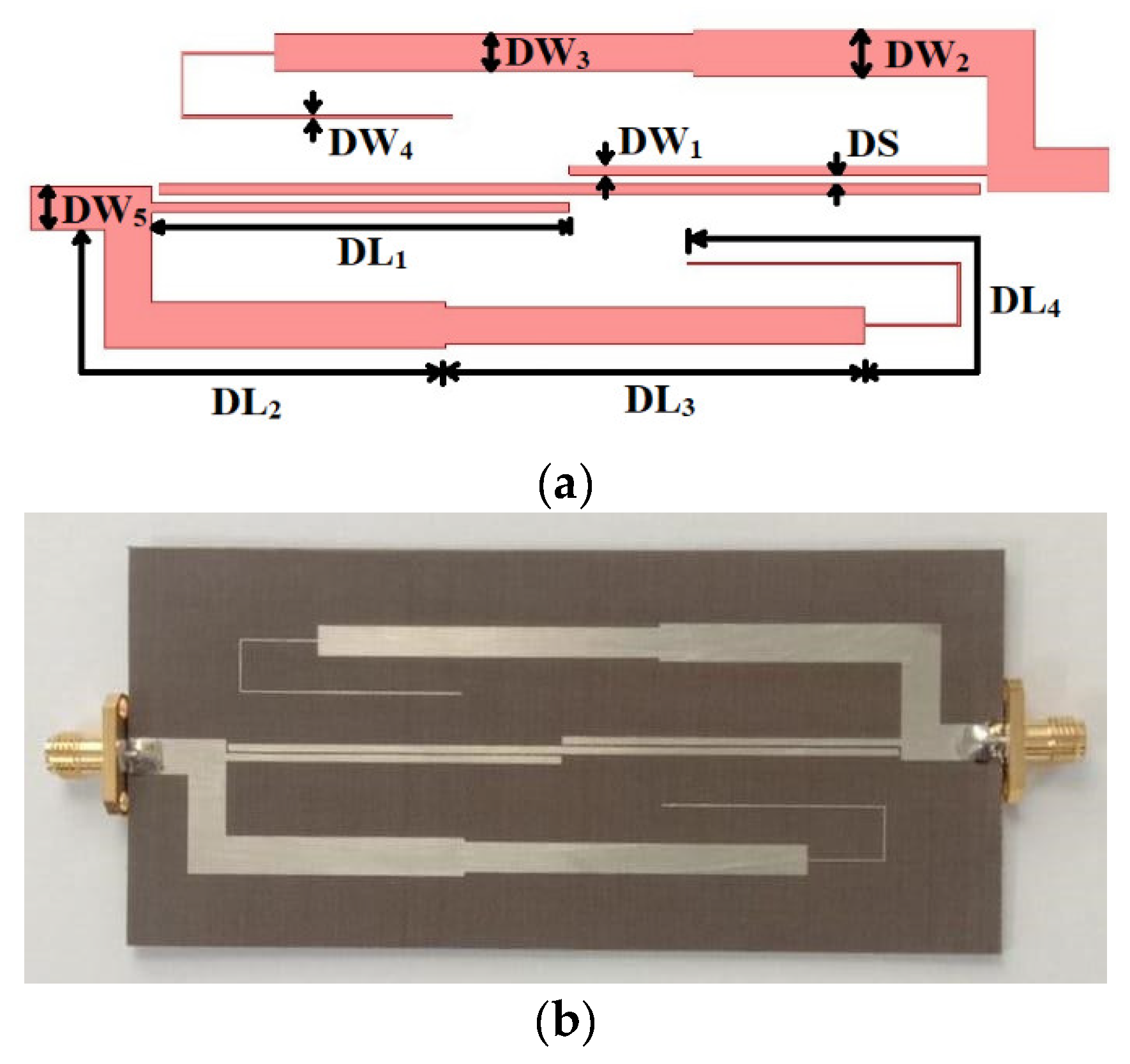


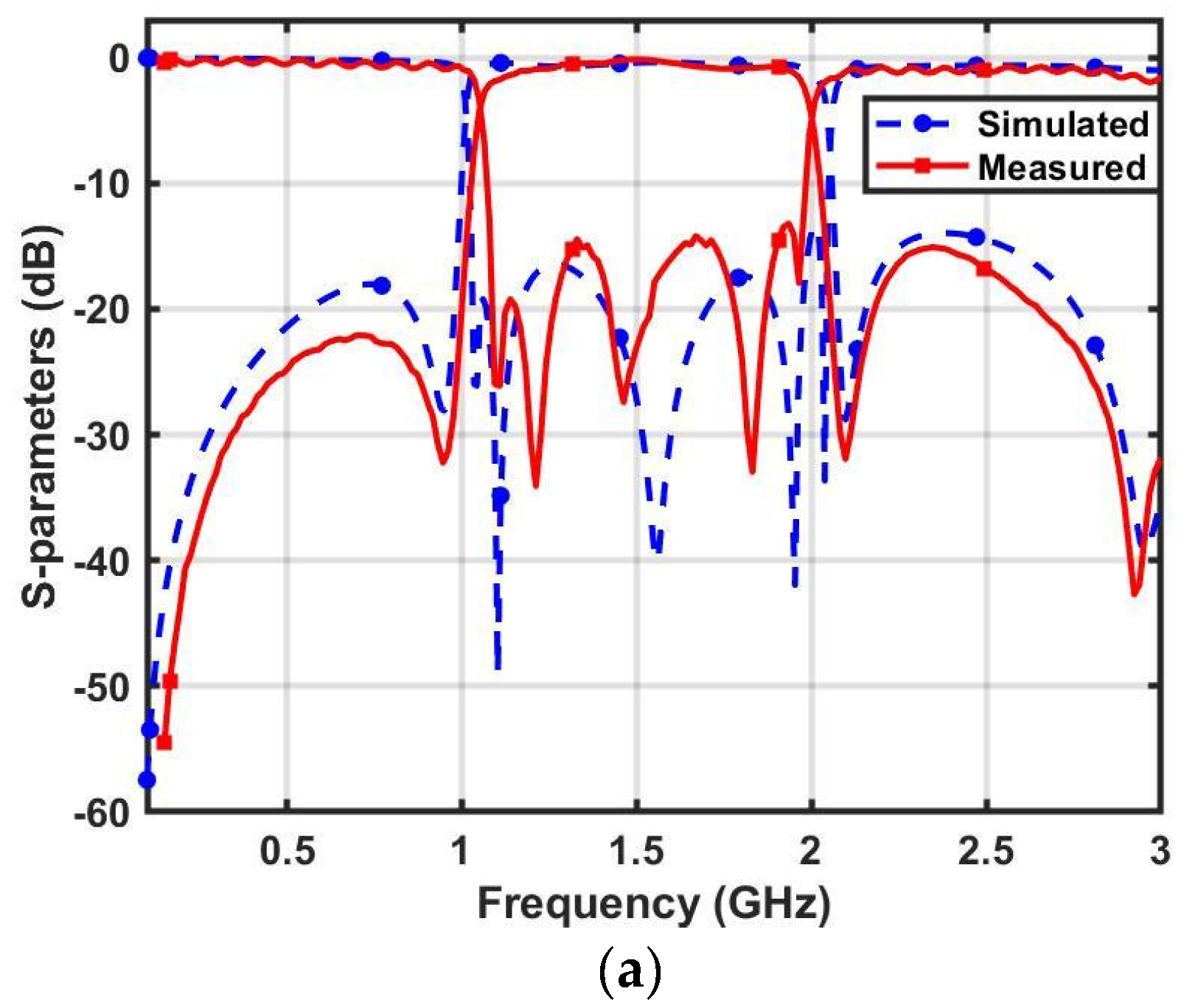
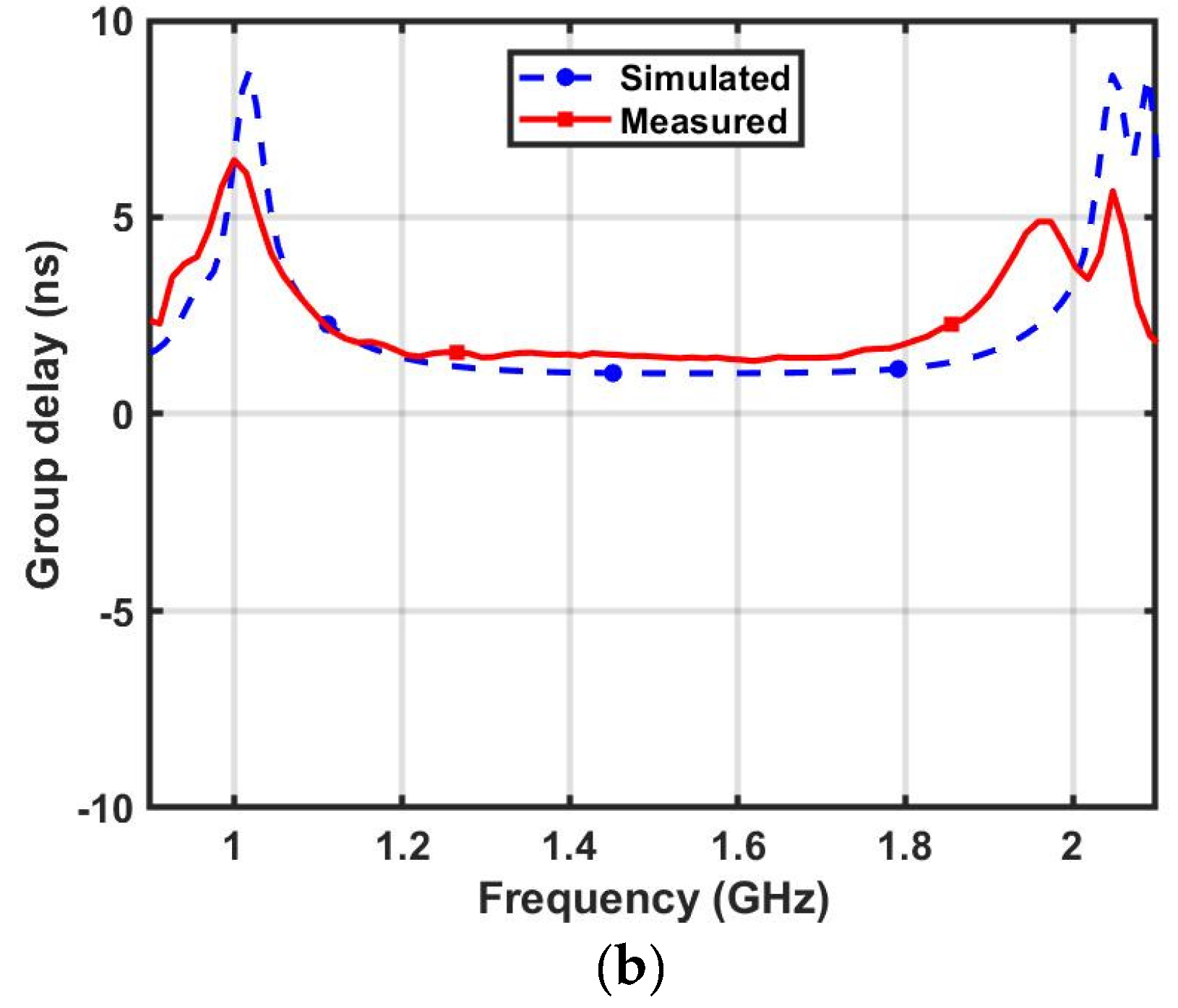
| Band | Parameter | Simulated | Measured |
|---|---|---|---|
| First Passband | 3 dB bandwidth (GHz) | 0.68–1.08 | 0.75–1.1 |
| Center frequency (f1) GHz | 0.88 | 0.92 | |
| IL (dB) @ f1 | 0.51 | 1.01 | |
| RL (dB) @ f1 | 15.08 | 14 | |
| Roll-off rate (dB/GHz) | 850/170 | 425/242 | |
| Second Passband | 3 dB bandwidth (GHz) | 1.38–1.75 | 1.35–1.69 |
| Center frequency (f2) GHz | 1.56 | 1.52 | |
| IL (dB) @ f2 | 0.64 | 0.96 | |
| RL (dB) @ f2 | 18.16 | 16 | |
| Roll-off rate (dB/GHz) | 212/566 | 340/283 |
| Ref. | f1/f2 (GHz) | CFR | IL1/IL2 (dB) | 3 dB FBW (%) | TZs | Size (λg × λg) |
|---|---|---|---|---|---|---|
| [1] | 2.45/5.2 | 2.12 | 1.3/2.8 | 7/4 | 3 | 0.27 × 0.27 |
| [4] | 1.8/5.8 | 3.22 | 1.2/2.0 | 12.2/4.4 | 4 | 0.37 × 0.28 |
| [6] | 3.5/5.25 | 1.5 | 1.87/2.33 | 6.5/4.3 | 2 | 0.45 × 0.32 |
| [7] | 3.73/4.29 | 1.15 | - | 3.2/5.7 | 7 | 0.32 × 0.28 |
| [8] | 2.4/5.8 | 2.41 | 1.35/1.97 | 4.63/3.6 | 3 | 0.39 × 0.25 |
| [9] | 1.8/2.4 | 1.33 | 0.07/0.08 | 7.91/3.89 | 3 | 0.46 × 0.34 |
| [10] | 2.65/4.84 | 1.82 | 0.99/1.39 | 6.04/8.7 | 5 | 0.44 × 0.3 |
| [11] | 3.45/5.27 | 1.52 | 1.76/2.56 | 10.7/4 | 5 | 0.23 × 0.31 |
| [12] | 3.4/5.4 | 1.58 | 1.2/1.4 | 5.8/11.8 | 4 | 0.24 × 0.25 |
| [13] | 1.17/2.85 | 2.43 | 0.95/1.87 | 13.67/3.5 | 7 | 0.29 × 0.17 |
| [14] | 1.33/2.82 | 2.12 | 1.16/2.46 | 7.5/2.83 | 7 | 0.29 × 0.3 |
| [15] | 2.33/4.36 | 1.87 | 2/2.2 | 6/5.7 | 5 | 0.28 × 0.23 |
| [16] | 1.25/1.92 | 1.53 | 0.77/0.5 | 7.6/8.4 | 4 | 0.31 × 0.46 |
| This work | 0.92/1.52 | 1.65 | 1.01/0.96 | 38.04/22.36 | 5 | 0.13 × 0.41 |
| Parameter | Simulated | Measured |
|---|---|---|
| 3 dB BW range (GHz) | 1.01–2.07 | 1.04–1.99 |
| Center frequency (fC) GHz | 1.54 | 1.51 |
| IL (dB) @ fC | 0.38 | 1.01 |
| RL (dB) @ fC | 30.41 | 15 |
| Selectivity factor | 0.96 | 0.90 |
| Ref. | fC (GHz) | 3 dB FBW (%) | TZs/TPs | IL (dB) | Selectivity Factor | Size (λg × λg) |
|---|---|---|---|---|---|---|
| [20] | 3.2 | 20.6 | 6/6 | 2.2 | 0.79 | 1.06 × 0.61 |
| [21] | 13 | 48 | 2/6 | 1.1 | 0.88 | 1.97 × 0.78 |
| [22] | 2.2 | 10 | 2/5 | 0.9 | 0.70 | 0.26 × 0.05 |
| [23] | 3.24 | 58.3 | 2/5 | 0.6 | 0.83 | 0.34 × 0.34 |
| [25] | 2.5 | 50 | 2/5 | 0.5 | 0.62 | -- |
| [27] | 2.1 | 19 | 8/3 | 1.8 | 0.77 | 0.39 × 0.28 |
| [28] | 2.7 | 66.6 | 3/3 | 0.8 | 0.77 | 0.20 × 0.20 |
| [29] | 6.95 | 97 | 2/3 | 0.42 | 0.69 | 0.128 × 0.378 |
| [30] | 3.69 | 73.17 | 4/5 | 1.07 | 0.81 | 0.74 × 0.94 |
| [34] | 1.25 | 62.4 | 4/3 | 0.9 | 0.69 | 0.23 × 0.13 |
| This work | 1.51 | 62.91 | 4/5 | 1.01 | 0.90 | 0.18 × 0.52 |
Disclaimer/Publisher’s Note: The statements, opinions and data contained in all publications are solely those of the individual author(s) and contributor(s) and not of MDPI and/or the editor(s). MDPI and/or the editor(s) disclaim responsibility for any injury to people or property resulting from any ideas, methods, instructions or products referred to in the content. |
© 2023 by the author. Licensee MDPI, Basel, Switzerland. This article is an open access article distributed under the terms and conditions of the Creative Commons Attribution (CC BY) license (https://creativecommons.org/licenses/by/4.0/).
Share and Cite
Alazemi, A.J. Dual-Band and Wideband Bandpass Filters Using Coupled Lines and Tri-Stepped Impedance Stubs. Micromachines 2023, 14, 1254. https://doi.org/10.3390/mi14061254
Alazemi AJ. Dual-Band and Wideband Bandpass Filters Using Coupled Lines and Tri-Stepped Impedance Stubs. Micromachines. 2023; 14(6):1254. https://doi.org/10.3390/mi14061254
Chicago/Turabian StyleAlazemi, Abdullah J. 2023. "Dual-Band and Wideband Bandpass Filters Using Coupled Lines and Tri-Stepped Impedance Stubs" Micromachines 14, no. 6: 1254. https://doi.org/10.3390/mi14061254
APA StyleAlazemi, A. J. (2023). Dual-Band and Wideband Bandpass Filters Using Coupled Lines and Tri-Stepped Impedance Stubs. Micromachines, 14(6), 1254. https://doi.org/10.3390/mi14061254





